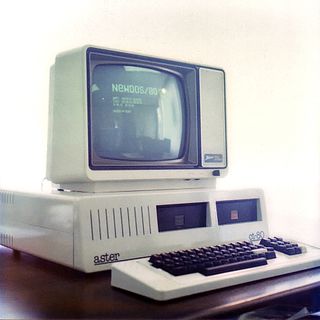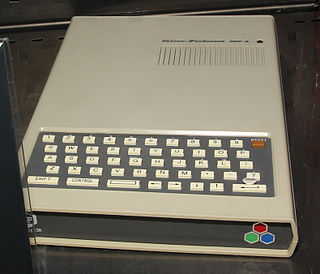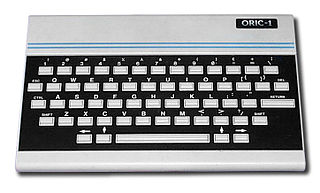
The Aster CT-80 is a 1982 personal computer developed by the small Dutch company MCP, was sold in its first incarnation as a kit for hobbyists. Later it was sold ready to use. It consisted of several Eurocard PCB's with DIN 41612 connectors, and a backplane all based on a 19-inch rack configuration. It was the first commercially available Dutch personal/home computer. The Aster computer could use the software written for the popular Tandy TRS-80 computer while fixing many of the problems of that computer, but it could also run CP/M software, with a large amount of free memory Transient Program Area, (TPA) and a full 80×25 display, and it could be used as a Videotext terminal. Although the Aster was a clone of the TRS-80 Model I it was in fact more compatible with the TRS-80 Model III and ran all the software of these systems including games. It also had a built-in speaker which was compatible with such games software.

The TRS-80 Micro Computer System is a desktop microcomputer developed by American company Tandy Corporation and was sold through their Radio Shack stores. Launched in 1977, it is one of the earliest mass-produced and mass-marketed retail home computers. The name is an abbreviation of Tandy Radio Shack, Z80 [microprocessor], referring to its Zilog Z80 8-bit microprocessor.

Amstrad plc was a British consumer electronics company, founded in 1968 by Alan Sugar. During the 1980s, the company was known for its home computers beginning with the Amstrad CPC and later also the ZX Spectrum range after the Sinclair deal, which led it to have a substantial share of the PC market in Britain. In the following decade it shifted focus towards communication technologies, and its main business during the 2000s was the manufacture of satellite television set-top boxes for Sky, which Amstrad had started in 1989 as the then sole supplier of the emerging Sky TV service.

MSX is a standardized home computer architecture, announced by ASCII Corporation on June 16, 1983. It was initially conceived by Microsoft as a product for the Eastern sector, and jointly marketed by Kazuhiko Nishi, the director at ASCII Corporation. Microsoft and Nishi conceived the project as an attempt to create unified standards among various home computing system manufacturers of the period, in the same fashion as the VHS standard for home video tape machines. The first MSX computer sold to the public was a Mitsubishi ML-8000, released on October 21, 1983, thus marking its official release date.

The Amstrad PC1512 was Amstrad's mostly IBM PC-compatible computer system, launched in 1986, and advertised with prices from £399 plus VAT. The system was also marketed in the US by Texas-based Vidco Inc. from the start of 1987. Later in 1987, a slightly updated version called the PC1640 was introduced, also marketed as the PC6400 and Sinclair PC500. Schneider branded machines for the German market were also sold.

The Compaq Portable is an early portable computer which was one of the first IBM PC compatible systems. It was Compaq Computer Corporation's first product, to be followed by others in the Compaq Portable series and later Compaq Deskpro series. It was not simply an 8088-CPU computer that ran a Microsoft DOS as a PC "work-alike", but contained a reverse-engineered BIOS, and a version of MS-DOS that was so similar to IBM's PC DOS that it ran nearly all its application software. The computer was also an early variation on the idea of an "all-in-one".

The Rainbow 100 is a microcomputer introduced by Digital Equipment Corporation (DEC) in 1982. This desktop unit had a monitor similar to the VT220 and a dual-CPU box with both 4 MHz Zilog Z80 and 4.81 MHz Intel 8088 CPUs. The Rainbow 100 was a triple-use machine: VT100 mode, 8-bit CP/M mode, and CP/M-86 or MS-DOS mode using the 8088. It ultimately failed to succeed in the marketplace which became dominated by the simpler IBM PC and its clones which established the industry standard as compatibility with CP/M became less important than IBM PC compatibility. Writer David Ahl called it a disastrous foray into the personal computer market. The Rainbow was launched along with the similarly packaged DEC Professional and DECmate II which were also not successful. The failure of DEC to gain a significant foothold in the high-volume PC market would be the beginning of the end of the computer hardware industry in New England, as nearly all computer companies located there were focused on minicomputers for large organizations, from DEC to Data General, Wang, Prime, Computervision, Honeywell, and Symbolics Inc.

Micro-Professor II (MPF-II) is an Apple II clone introduced in 1982 by Multitech. It is Multitech second branded computer product and also one of the earliest Apple II clones. The MPF II doesn't look like most other computers, with its case being a slab with a small chiclet keyboard on the lower part.

The EACA EG2000 Colour Genie was a computer produced by Hong Kong–based manufacturer EACA, and introduced in Germany in August 1982 by Trommeschläger Computer Service and Schmidtke Electronic.

The PC-6000 series is a series of 8-bit home computers introduced in November 1981 by NEC Home Electronics. There are several models in this series, such as the PC-6001, the PC-6001 MK2 and the PC-6001 MK2 SR. There is also an American version, called the NEC TREK or NEC PC-6001A.
Atari 8-bit computer peripherals include floppy drives, printers, modems, and video game controllers for Atari 8-bit computers, which includes the 400/800, XL, XE, and XEGS.

The PC-8000 series is a line of personal computers developed for the Japanese market by NEC. The PC-8001 model was also sold in the United States and Canada as the PC-8001A.

The Dick Smith Super-80 was a Zilog Z80 based kit computer developed as a joint venture between Electronics Australia magazine and Dick Smith Electronics.

The Sharp PC-1600 was a pocket computer introduced by Sharp in 1986 as a successor to the PC-1500. The PC-1600 provided compatibility with its predecessor through the use of a slave CPU that could run assembly language programs targeting the older machine. It could also switch into a compatibility mode so that programs written for the single line display of the PC-1500 could work with the four line display of the PC-1600.

Home computers were a class of microcomputers that entered the market in 1977 and became common during the 1980s. They were marketed to consumers as affordable and accessible computers that, for the first time, were intended for the use of a single, non-technical user. These computers were a distinct market segment that typically cost much less than business, scientific, or engineering-oriented computers of the time, such as those running CP/M or the IBM PC, and were generally less powerful in terms of memory and expandability. However, a home computer often had better graphics and sound than contemporary business computers. Their most common uses were word processing, playing video games, and programming.

Oric was a brand of home computers sold in the 1980s by Tangerine Computer Systems. Tangerine was based in the United Kingdom and sold their computers primarily in Europe. All computers in the Oric line were based on the MOS Technology 6502A microprocessor.
Sharp MZ character sets are character sets made by Sharp Corporation for Sharp MZ computers. The European and Japanese versions of the software use different character sets.
The MZ-2500, also known as the Super MZ, is an 8-bit personal computer released on 1 October 1985 as part of the Sharp MZ series. It is a successor to the MZ-2000/2200 and a direct successor to the MZ-80B from the previous generation. The MZ-2000 was a model that was given significant functions, along with a faster processing speed. It is also the final model of the entire 8-bit MZ series with architecture of its kind. It is sometimes referred to as the best 8-bit machine along with the 6809 FM77AV and the MB-S1. In Japanese computer magazines, the MZ-2500 was also called 'The Phoenix'. Its successor was the Sharp MZ-2861 which has a compatible mode and a newly developed 16-bit mode. The development code is LEY and can be found in the circuit diagram.
Hector are a series of a microcomputers produced in France in the early 1980s.




















